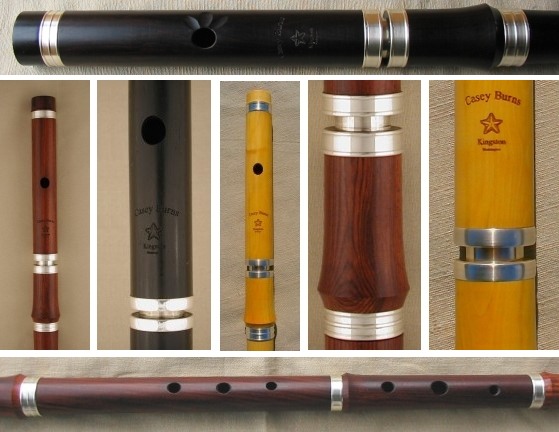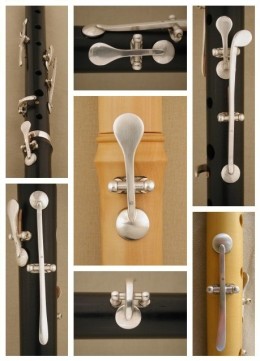![[crinoid image]](/img/stamp.gif)
Kingston
Washington
Catalog
New: The Irish Flute Combo
Ergonomic Flute Discussion
Low Flutes
Ordering
About Casey
Contact
HOME
![[Photo collage of forged sterling silver keys on a blackwood Casey Burns Irish flute]](img/BW_silver_collage_small.jpg)
The silver work on Casey Burns flutes is characterized by meticulous craftsmanship and attention to each individual flute. Sterling silver keys are forged and rings are turned to enhance the function, strength, and beauty of the each instrument. The techniques used to uniquely fit slide, rings, and keys to each instrument comprise a wealth of details, each contributing to a more gratifying ownership and playing experience.
Hand-forging keys, turning rings, and drawing the tuning slide tubes to the unique bore diameters of each acoustical model are extremely labor-intensive techniques, but result in a superior instrument. The junction of metal and wood demands particular care, which pays off handsomely in better tonal performance, structural integrity, and aesthetic proportions.
Casey's long study of flute ergonomics is evident in the keys as well as tone hole placement: keys should be ready when needed but not be in the way. Great attention is given to the fit of each key with respect to the fingers.
Tuning Slides and Turned Sterling Silver Rings
Sterling Rings (also called bands) are requested for various reasons: tradition, beauty, strength...ultimately it is yours to decide if you want a wood-only flute or to add rings. Wood-only flutes are more than sufficiently robust, and a flute with rings is a pleasure to own and will retain value. However, if you choose a tuning slide, the reinforcement provided by the rings is necessary. While all Casey Burns flutes are tuneable (thanks to the long threaded tenon), some players will require the extra tunability and aesthetic enhancement of a tuning slide over a simple tenon.
Casey Burns provides forged, lathe-turned sterling silver rings and custom-fitted tuning slides (detail photos below). We partially line the head joint with the slide, so that the critical voicing details are not hampered by the metal. The tuning slides consist of a brass inner slide, and a nickel silver outer slide, custom drawn to the proper bore diameter. The metal is thinned between points of contact, so that the metal bears against the wood in two places rather than the entire length, eliminating cracking. Since developing these techniques, Casey has not had a single tuning slide head joint returned for cracking.
The sterling silver rings are hand forged to shape. Final shaping and fitting are done on the lathe. Rings are given a satin finish to complement the polish of the wood. Rings and tuning slide are ordered together as one option on D flutes.

All of our D wood-only flute models (except the Folk Flute) may be retrofitted with Sterling rings and tuning slide. Wood-only low flutes may be retrofitted with rings only.
Forged Sterling Silver Keys
Every possible attention is given to the fashioning and placement of Casey's keys to support the ergonomic, responsive, and silent functioning of the keys. Fingers need not be bent around or jammed-up against the keywork to reach the tone holes. Springing of the keys is done carefully to provide a firm acoustical seal yet open effortlessly. All the mechanical aspects are custom fit to fine tolerances providing rapid, smooth, and silent action.
Casey Burns flutes feature post mounted keywork, such as is used on modern clarinets and oboes. The posts are mounted to a silver strap which is then let in (flush-mounted), glued and screwed to the body, making a very secure mounting.This results in better structure and a cleaner appearance compared to straps mounted on the surface of the flute body. Keywork may be retrofitted, and has the advantage of being serviceable by any competent woodwind repair technician.
Sterling silver keys, like all silverwork on Casey Burns flutes, are given a long-wearing satin finish. In addition to complementing the polish of the wood, this finish will not show fingerprints to the same degree as common "bright" polished silver.
CLOCKWISE FROM TOP LEFT (click on the image to enlarge it in a new window):

- A view of middle joint keywork from foot joint towards the head joint. Note the slender touch of the Short F. In the enlarged view, an inset cork bumper may be seen allowing the key to be set lower.
- Short Bb key detail, showing also the cup of the long C natural.
- G# and Long F keys.
- Long Bb key. The 5-key configuration leaves off the C natural key (below), as C natural cross-fingers so easily. The long Bb key takes the place of the long C natural key, making the Bb accessible by the first finger of the right hand, rather than the left thumb.
- Short F key. The touch for this key is slender to avoid intruding on the travel of the third and fourth fingers of the right hand.
- C natural and short Bb keys are included in a traditional 6-key configuration. 5-key flutes, which leave off the C natural key have instead a long Bb key.
- (center)Eb key--no other keys, rings, tuning slide. While most chromatic notes can be satisfactorily cross-fingered or half-holed, the Eb may not. A common configuration on simple-system flutes through the early 20th century, this is an excellent, economical option for a fully chromatic flute.
Flutes are offered in 1, 4, 5, and 6 key configurations. We invite you to see the FAQ on keys for more discussion on wooden flute keys, and consult with us on the best key configuration for your requirements. Pricing for keywork on D flutes may be found in the price schedule on the D flute catalog page.
|
Page last modified: January 06 2021 |
© Casey Burns 1981-2007 |
|